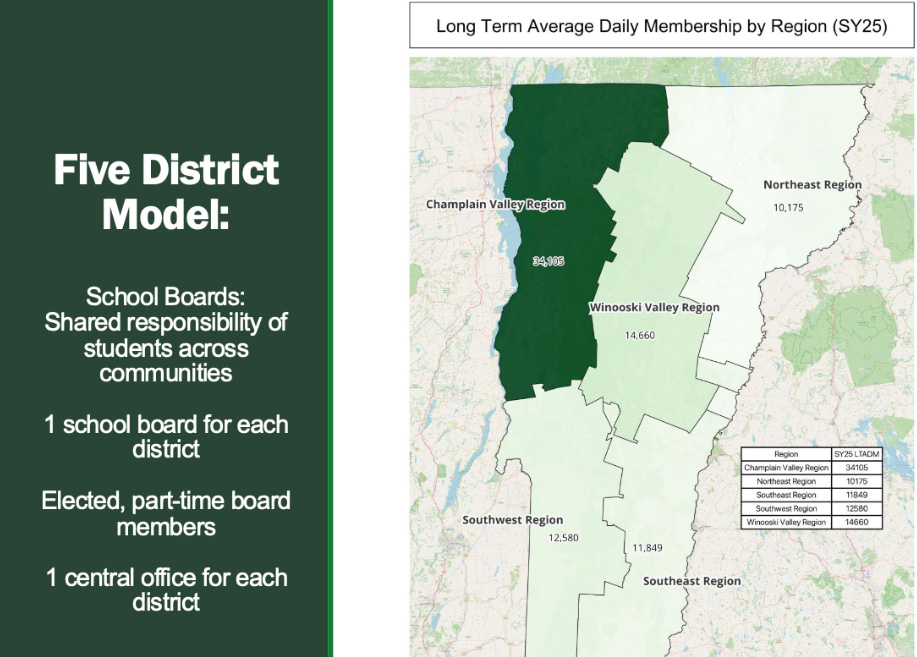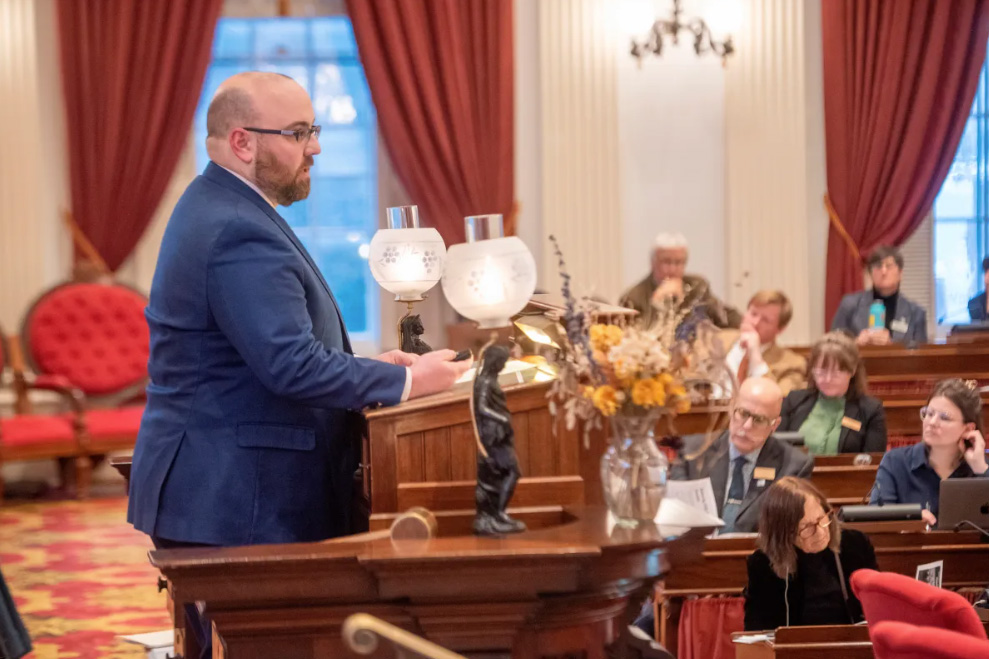by Ethan Weinstein/VTDigger
State officials unveiled the broad strokes of Gov. Phil Scott’s education proposal on Wednesday, Jan. 22, a plan that includes sweeping changes like consolidating Vermont’s dozens of school districts to just five and adopting a foundation formula.
“We know that the work that we’re describing here is going to be really challenging,” Zoie Saunders, Vermont’s secretary of education, said in a briefing before the entire Legislature. “I ask you to join us so we can be bold together.”
Scott, a Republican, first hinted at the proposal during his inaugural address earlier this month, including a shift to a foundation formula and a change in school governance structures. In a foundation formula, districts are provided a base amount of money per student.
The proposal eliminates the concept of “supervisory unions,” suggesting instead five regional districts: the Champlain Valley region, Winooski Valley region, Northeast region, Southwest region, and Southeast region. Each district would have roughly 10,000-15,000 students, except for the Champlain Valley district, which would have closer to 34,000.
Vermont’s current system lacks “incentives” for districts to save money and is “too complicated for people to understand,” said Craig Bolio, Vermont’s tax commissioner, who joined Saunders in making the presentation.

Democratic legislative leaders expressed positive initial reactions to the wide-ranging proposal.
“The Legislature and the Governor are aligned in the belief that we must take on the serious task of transforming our education system so all Vermont kids have the opportunity to thrive,” House Speaker Jill Krowinski, D-Burlington, and Senate President Pro Tempore Phil Baruth, D/P-Chittenden Central, said in a joint statement. “The details matter, and we need to get it right.”
The unified call for education finance reform arrives after education property taxes rose an average of 13.8% last year. This year, the tax department has predicted a 5.9% increase in property taxes.
Scott has said he will propose a plan to prevent property tax increases this year. Officials did not address Wednesday how that would be achieved, but documents provided to legislators said it would involve “infusing other State funds on a one-time basis.”
While the administration’s presentation heralded the beginning of a push for their education omnibus package, some key details remained scarce.
Officials did not specify the base payment per student under the proposed funding formula. But Saunders said it would be “very generous … compared to spending in other states,” calling the decision “the most critical part” of the funding change.
During a short press conference following the briefing, officials indicated the base would be greater than that outlined in an October 2024 report, which suggested the state could save $400 million on education by totally changing the footprint of its public school system.
According to Saunders, the exact number will arrive in the “coming weeks.“ The funding plan would also account for students who are more expensive to educate, including English language learners and economically disadvantaged students.
In the new system, districts could choose to raise limited additional funds through local property taxes.
During the press conference, Bolio said there would be a “cap” on additional spending, though the exact cap would be a “policy choice.” Speaking to the mechanism for raising additional funds, he said there would be a “state guarantee to make sure the disparities between property wealth is accounted for in the system.”
To address consolidation, schools will “be assessed based on financial viability and educational quality,” according to the documents, and “schools that fall short of these standards will be offered a range of options, including resource sharing or merging, with support from the AOE.” The plan also distinguishes between “small due to necessity” and “small by choice,” a distinction that Saunders said would be “practical and intentional.”
Following the briefing, Saunders indicated the state would make decisions about school closures and consolidation.

Tax commissioner Craig Bolio briefed a joint session of the legislature Wednesday, Jan. 22, on Gov. Phil Scott’s education funding plans.
“What we’ve been hearing is, historically, we’ve been pushing down a lot of these really hard decisions at the local level,” she said. “Districts are working to think intentionally around how they can consolidate to provide different resources for students, but they often tell us that they lack cover from the state to be able to make those important decisions.”
According to the documents, the plan calls for “regional comprehensive high schools, central middle schools, local elementary schools.” Currently, Vermont has 52 supervisory unions and supervisory districts—the overarching administrative units that often include multiple boards and school districts.
The five districts would have part-time elected school board members who would be paid. To compensate for the reduction in local control, the plan proposes “school advisory councils.” The councils, composed of caregivers, educators, and students, would have input on budget development and strategic planning.
Saunders acknowledged the proposal would require substantial rulemaking in the coming years. As part of that need, the plan also calls for shifting rulemaking authority from the State Board of Education to the Agency of Education.
School choice was among the topics not addressed Wednesday. Saunders said the administration would address certain policy areas, including school choice, “more fully” in the coming weeks.
A proposed and preliminary timeline included in the plan documents suggests adopting the foundation formula for the 2026-27 school year. The following year would “fully move to (the) new funding and governance system.” The 2028-29 school year and into the future would involve “(rescaling) the school portfolio.”
Not everyone viewed Scott’s ideas positively. The state’s teachers union, the Vermont NEA, criticized the plan’s lack of specifics.
“Today’s risky proposal is big on rhetoric but short on the details. And the details matter — a lot,” Don Tinney, the union’s president, said in a statement. “It doesn’t explain how these changes would be better for students. It doesn’t simplify an overly complex school funding system. And it doesn’t provide immediate and ongoing property tax relief for middle-class Vermonters.”




